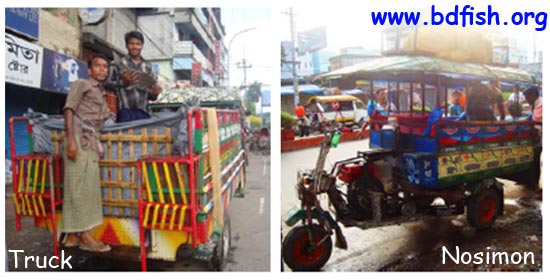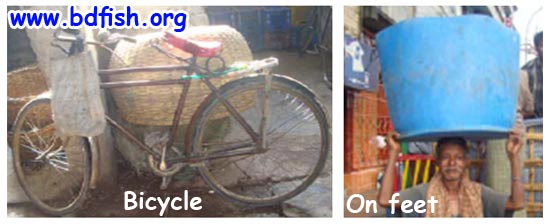Transportation of fish should be very effective for proper distribution of fishes to the consumers. It is an important aspect of fisheries as both live, fresh and preserved fishes can be transported from one place to another as per requirements. In Bangladesh everyday huge number of fish and other fisheries items are being caught both from inland and marine water resources. But lack of proper preservation and transportation facilities, a noticeable amount of fishes are either damaged or spoiled losing their quality. For proper transportation, suitable containers and transporters (fish carrying vehicles) are essential. The quality of fish highly depends on these two factors. Different types of containers and vehicles are sued for marketing of fishes in different observed fish markets.
Survey has been made on the following fish markets in Rajshahi City Corporation area:
- Shaheb Bazar fish market
- Laxmipur fish market
- New market fish bazar
- Shalbagan fish market
- Binodur fish market
- Kajla fish market
- Talaimari fish market
- Sadhur mor fish market
- University station bazar fish market
- Siroil fish market
- Uposhohor fish market
- Khorkhori fish market
- Court bazar fish market
The details of transportation vehicles are described below-
Transportation vehicles:
Different types of mechanical and non-mechanical vehicles are used for transporting fish to the fish markets. During the present study several types of vehicles were found to carry the fish. These vehicles can be grouped into-
- Mechanized vehicles
- Non-mechanized vehicles
Mechanized vehicles
Truck:
Truck is mainly used for tong distance fish transportation. Normally large quantities of fish are transported by using this mechanical vehicle. High valued species like hilsa, larger catla, rui, mrigel etc. are transported by truck.
Nosimon and Tempoo:
Another mechanical vehicle used for fish transportation is nosimon and tampoo. Normally nosimon is used for comparatively short distance transportation than truck. Also smaller amounts of fish are carried both in live or fresh condition.

Table 01: Fish transportation by mechanized vehicles (truck and Nosimon)
| Issue | Truck | Nosimon |
| Distance | Long | Comparatively short |
| Quantity of fish | Large | Comparatively small |
| Transportation type | Live and Fresh | Live and Fresh |
| Transported species Generally | Generally high valued fish like hilsa, large rui, catla etc. | Generally cultured fish from adjacent areas |
Non-mechanized vehicles:
Rickshaw:
Fish transportation by rickshaw is very common in the visited study areas. This vehicle is used when distance of transportation is short and amount of fish to be transported is comparatively smaller.
Van:
Among the non-mechanized vehicles, van is the most common fish transporter. Normally fish from adjacent areas are transported by using van. Both live and fresh fish are transported by using this vehicle.

Bicycle:
Most simple non-mechanized vehicle used for fish transportation is the bicycle. This vehicle is used only when transportation distance is short and quantity of fish to be transported is small.
On feet:
The retail fish hawker transport fishes in bamboo baskets on head and move on feet to the nearly locality. It is the most common way of transportation.

Table 02: Fish Transportation by non-mechanized vehicles
| Issue | Rickshaw | Van | Bicycle | On feet |
| Distance | Short | Short | Short | Short |
| Quantity of fish | Small | Medium | Small | Small |
| Condition of fishes | Live and Fresh | Live and Fresh | Normally fresh | Fresh |
| Transported species | All species | All species | Small carps and SIS | mall carps |
Problems of transporters:
Different problems of transporters used in transportation and fish markets, identified during the study period are listed below-
- Poor physical conditions of the transporters
- Use of dirty or un-cleaned transporters
- Use of broken transporters
- Overloading of fish in transporters
References
- DoF. 2006. Brief on Department of Fisheries Bangladesh. Department of Fisheries (DoF), Ministry o Fisheries and Livestock, Dhaka.
- Shammi, Q. J. and S. Bhatnagar. 2002. Applied Fisheries, Updesh Purohit for Agrobios (India), Jadhpur, India, 137. pp.
Visited 1,657 times, 1 visits today | Have any fisheries relevant question?
